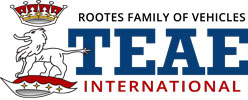from the April 2008 RootesReview:
The Rootes brothers, William and Reginald, began a car sales business after the First World War. They built a successful dealership in Kent before setting up shop in Long Acre, London. They took over Piccadilly’s Devonshire House in 1926 and used this facility as their headquarters.
The brothers’ reputation was one of knowing what the customer wanted, and they believed the customers were not getting what they desired.
By 1928 the Rootes brothers were the largest distributors in Great Britain. They decided to manufacture their own cars. They formed the Rootes Group by acquiring Hillman, Commer and Humber.
The brothers soon realized that the companies they bought had out dated facilities and antiquated manufacturing procedures. Turning these companies around was a monumental task, but William and Reginald were up to the task.
Karrier Motors and Clement-Talbot Ltd were also purchased. In 1937 they took over British Light Steel Pressings. In 1938 the Sunbeam Motor Car Company, Ltd was added to the growing Rootes Group. The Sunbeam company was merged with Clement-Talbot, Ltd to form Sunbeam-Talbot, Ltd.
All these companies were given a new lease on manufacturing life with their consolidation into the Rootes Group. They now had a central organization with the leverage and power to influence the automotive market place. The individual companies complemented each other with brand recognition as well as not infringing on each one’s market share.
1936 marked the beginning of the war effort by Rootes, predating the advent of World War II by about three years. They were the first English company to join the Shadow Factory Scheme of the government. The scheme was devised for volume manufacturing of airplanes and engines for them. By 1940 Rootes was producing airplanes and other vehicles for the Royal Air Force as well as other branches of the war effort.
William Rootes was appointed head of the Shadow Industry Scheme, while Reginald headed the Supply Council of the Ministry of Supply. Reginald was responsible for the Rootes Group assembly lines, making sure they were producing at maximum efficiency. He applied quantity production methods to the assembly of aero engine and aircraft construction, earning him Knighthood.
In 1940 the Germans bombarded Coventry with 35,000 incendiary bombs, 50 land mines and 1,400 high explosive bombs.
William Rootes found one of his greatest challenges in reconstructing the devastated city. As always, he met this challenge like all others, head on. For his work in Coventry he was awarded the position of Knight Commander of the British Empire. From that point on he was known as Lord Rootes.
Post-war analysis of records revealed that the Rootes Group had produced one of every seven bombers in the U.K., 60% of the armored cars and 30% of the scout cars. They also built 50,000 aircraft engines, repaired 28,000 others along with 12,000 vehicles for the English army and the Royal Air Force. Allied vehicles were sent to their shops for assembly during the war.
The Rootes Group pre-war payroll boasted 17,000 employees. By the end of the war one in every one hundred British civilians were working for or in the name of the Rootes Group.
The British economy in 1945 was in poor shape. The country needed to export in order to survive. The motoring industry stepped to the front and the Rootes Group began an intensive effort to export its products.
In 1931 the Group had established a sales organization in Latin America. It also was the first automotive company to produce cars in Australia, which was quickly becoming one of Britain’s prime market places. The plant in Australia was producing vehicles before the end of 1946.
Rootes set up manufacturing facilities abroad as well as new sales outlets in important markets outside of Great Britain and Europe.
To meet the demand for British cars, Rootes Motors, Incorporated was established as an independent company in New York City with distribution responsibilities for all major U.S. cities. Toronto, Canada became the main office for the Canadian counterpart of Rootes Motors, known as Rootes Motors (Canada) Ltd. Additional sites for this global expansion were Belgium and Brazil. Many other locations followed afterward.
By 1948 the Rootes Group had amassed 15 separate companies throughout the world, had manufacturing capabilities with 7,000,000 square feet of space, and exported to over 160 countries, compared 69 prior to World War II.
The Rootes group was distinct among British vehicle manufacturers, remaining a family owned and operated business. The first son of Lord Rootes, the Honorable Geoffrey Rootes, was Deputy Chairman and Managing Director of the Rootes manufacturing companies. Second son Honorable Brian Rootes became Managing Director of Rootes, Ltd, and the merchandizing company for the Group.
Timothy Rootes, son of Sir Reginald, was appointed Director in Charge of Sales and Service of the production companies. This responsibility covered over 1,000 dealerships throughout the United Kingdom.
The second generation followed closely in the footsteps of the first, prepared to carry on the family tradition of high quality manufacturing.

Comments (1)
Did the Rootes Group assemble cars in South Africa after 1945 or if not was South Africa a big export market for the Group in the immediate post war years?